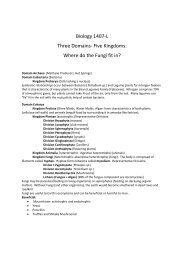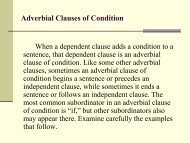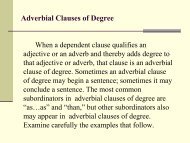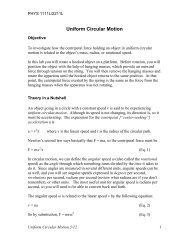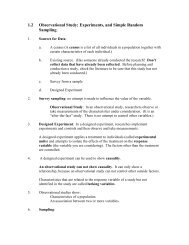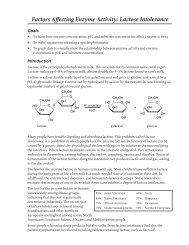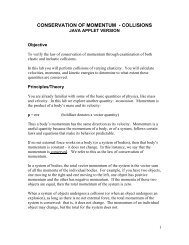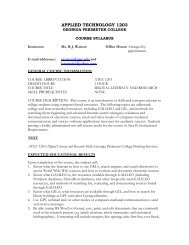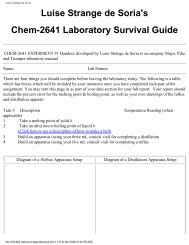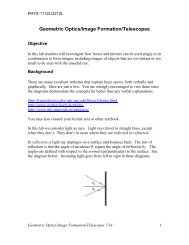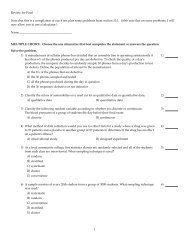Amines & Amides
Amines & Amides
Amines & Amides
Create successful ePaper yourself
Turn your PDF publications into a flip-book with our unique Google optimized e-Paper software.
<strong>Amines</strong> and <strong>Amides</strong>C. Neutralization of <strong>Amines</strong> with AcidsBecause amines are basic, they react with acids to form the amine salt. These amine salts are much moresoluble in water than the corresponding amines.D. <strong>Amides</strong>CH 3 ⎯NH 2 + HCl ⎯⎯→+CH 3 ⎯NH 3MethylamineMethylammonium chloride(amine salt)+ Cl -When a carboxylic acid reacts with ammonia or an amine, the product is an amide. The functional group,called the amide group, and some examples of amides are shown below:O O O O⎟⎟ ⎟⎟⎟⎟⎟⎟⎟⎯C⎯N⎯ CH 3 ⎯C⎯NH 2 ⎯C⎯NH 2 CH 3 ⎯C⎯NH⎯CH 3Amide Acetamide Benzamide N-MethylacetamideIn a reaction called amidation, an amide forms when a carboxylic acid is heated with ammonia or analkyl or aromatic amine.OO⎟⎟⎟⎟CH 3 ⎯C⎯OH + CH 3 ⎯NH 2 ⎯⎯→ CH 3 ⎯C⎯NH⎯CH 3Acetic acid Methylamine N-MethylacetamideHydrolysis of an AmideWhen an amide is hydrolyzed, the amide bond is broken and the carboxylic acid and the amine are separated.Hydrolysis takes place in either an acid or a base. Acid hydrolysis produces the carboxylic acidand ammonium salt. In a base, the hydrolysis reaction produces the salt of the carboxylic acid andammonia. The odor of ammonia and the reaction of ammonia with litmus paper are used to detect thehydrolysis reaction.OO⎟⎟⎟⎟CH 3 ⎯C⎯NH 2 + HCl ⎯⎯→ CH 3 ⎯C⎯OH + NH 4 ClAcetamide Acetic acid Ammonium chlorideOO⎟⎟⎟⎟CH 3 ⎯C⎯NH 2 + NaOH ⎯⎯→ CH 3 ⎯C⎯O - Na + + NH 3 (g)Acetamide Sodium acetate AmmoniaLab InformationTime:Comments:2 1 /2–3 hrSome amines have an irritating odor. Work in the hood. Tear out the report sheets andplace them next to the matching procedures.Related topics: <strong>Amines</strong>, solubility and pH of amines, amidation, amides, hydrolysis of amides
<strong>Amines</strong> and <strong>Amides</strong>Experimental ProceduresWEAR YOUR PROTECTIVE GOGGLES!A. Structure and Classification of <strong>Amines</strong>Materials: Organic model kitsA.1 Use a model kit to prepare or observe models of ammonia, methylamine, dimethylamine, trimethylamine,and aniline. Write the condensed structural formulas of each model in the laboratory report.A.2 Classify each amine as primary (1°), secondary (2°), or tertiary (3°).B. Solubility of <strong>Amines</strong> in WaterMaterials: Aniline, N-methylaniline, triethylamine, test tubes, test tube rack, stirring rod, pHpaperWORK IN THE HOOD. THE VAPORS OF AMINES AREIRRITATING TO THE NOSE AND SINUSES.B.1 To three separate test tubes, add 5 drops of aniline, N-methylaniline, and triethylamine. Draw thecondensed structural formulas of each amine and state its classification (1°, 2°, 3°).B.2 Cautiously note the odor of each. Remember to hold a fresh breath of air while you fan the vaportoward you. Record.B.3 Add 2 mL of water to each test tube. Stir. Describe their solubility in water.B.4 Determine the pH of each solution. Dip a stirring rod in each amine solution and then touch it topH paper. Record. Save these test tubes and samples for part C.C. Neutralization of <strong>Amines</strong> with AcidsMaterials: Test tubes from part B, blue litmus paper, 10% HClC.1 Add 10% HCl dropwise to the amine solution until the solution is acidic to litmus paper. Recordany changes in solubility of each amine. Note any changes in odor.C.2 Write and balance equations for the neutralization of aniline, N-methylaniline, and triethylaminewith HCl.D. <strong>Amides</strong>Materials: Organic model kit, acetamide, benzamide, test tubes, spatula, 10% HCl, 10% NaOH,250-mL beaker for water bath, hot plate, red litmus paperD.1 Make a model of acetic acid and ammonia. Show how the structures change in the formation ofacetamide. Write the equation for the amidation.
<strong>Amines</strong> and <strong>Amides</strong>D.2 Place small amounts (tip of a spatula) of acetamide and benzamide in separate test tubes.Cautiously note the odor. Add 2 mL of water to each. Record the solubility of each in water.OO⎟⎟⎟⎟CH 3 C⎯NH 2 ⎯C⎯NH 2AcetamideBenzamideHydrolysis of an AmideD.3 Make a model of acetamide and HCl. Use the models to show the hydrolysis reaction of the amidewith HCl, and write the equation.D.4 Using the test tubes from D.2, add 2 mL of 10% HCl to each. Place the test tubes in a boilingwater bath and heat gently for 5 minutes. Cautiously note any odor coming from each mixture.Record your observations.D.5 Prepare two more test tubes as you did in part D.2. Add 2 mL of 10% NaOH to each. Place the testtubes in a boiling water bath. Wet a piece of pH paper or red litmus paper and hold over the mouthof each test tube. Heat the tubes gently for 5 minutes. Record any change in the color of the litmuspaper. Cautiously note any odor coming from each mixture. Record your observations. Write theequation for the hydrolysis of acetamide in base.
<strong>Amines</strong> and <strong>Amides</strong>Report SheetDate ___________________________ Name _________________________________Section _________________________ Team _________________________________Instructor _______________________Pre-Lab Study Questions1. What is the functional group in amines? In amides?2. What products are formed when amides are hydrolyzed?3. How is the amide bond important in proteins?A. Structure and Classification of <strong>Amines</strong>Compound A.1 Condensed Structural Formula A.2 Classification (1°, 2°, 3°)AmmoniaMethylamineDimethylamineTrimethylamineAnilineQuestions and ProblemsQ.1 In the discussion, the structures are given for Neo-Synephrine and methamphetamine. Give theamine classification of each of the compounds.
<strong>Amines</strong> and <strong>Amides</strong>Report SheetB. Solubility of <strong>Amines</strong> in WaterB.1 CondensedstructuralformulaAniline N-Methylaniline TriethylamineClassification1°, 2°, 3°B.2 OdorB.3 Solubility inwaterB.4 pHQuestions and ProblemsQ.2 What type of compound accounts for the “fishy” odor of fish?Q.3 Explain why amines are basic.
Report Sheet<strong>Amines</strong> and <strong>Amides</strong>C. Neutralization of <strong>Amines</strong> with AcidsC.1 Solubilityafter addingHClAniline N-Methylaniline TriethylamineOdor after addingHClC.2 Equation for the neutralization of aniline with HClEquation for the neutralization of N-methylaniline with HClEquation for the neutralization of triethylamine with HClQuestions and ProblemsQ.4 How does lemon juice remove the odor of fish?Q.5 Write an equation for the reaction of butylamine with HCl.
<strong>Amines</strong> and <strong>Amides</strong>Report SheetD. <strong>Amides</strong>D.1 Equation for the formation of acetamideAcetamideBenzamideD.2 OdorSolubilityD.3 Equation for the hydrolysis of acetamide in acid.AcetamideBenzamideD.4 Odor after adding HClD.5 Odor after adding NaOHChange in red litmus paperEquation for the hydrolysis of acetamide in base.Questions and ProblemsQ.6 You have unknowns that are a carboxylic acide, an ester, and an amine. Describe how you woulddistinguish among them.


